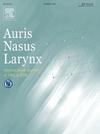Developing a ground truth for a convolutional neural network-based segmentation of anatomical structures in endoscopic ear surgery videos
IF 1.5
4区 医学
Q2 OTORHINOLARYNGOLOGY
引用次数: 0
Abstract
Objective
This study aimed to develop a ground truth for a convolutional neural network-based segmentation of the stapes, chorda tympani and facial nerve in endoscopic ear surgery videos, and to evaluate the accuracy of artificial intelligence (AI) predictions on test videos.
Methods
Forty prospectively-gathered endoscopic ear tympanotomy videos were segmented to establish a ground truth. This ground truth was used to prime a convolutional neural network (CNN) to predict the stapes, chorda tympani and facial nerve. The CNN was then tested on an unlabeled series of videos, and the accuracy of predictions compared to ground truth labeling by calculating Dice scores, sensitivity and specificity.
Results
An overall Dice score of 77.94 % across all three elements was obtained, with a sensitivity of 78.42 % and specificity of 99.79 %.
Conclusion
Convolutional neural network analysis is effective at identifying key anatomical structures in endoscopic ear surgery videos. Further validation of the CNN on additional video datasets is necessary to optimize model performance.
为内窥镜耳部手术视频中基于卷积神经网络的解剖结构分割开发一个基础真值
本研究旨在开发基于卷积神经网络的内窥镜耳科手术视频中镫骨、鼓室索和面神经分割的基础真值,并评估人工智能(AI)对测试视频预测的准确性。方法对40个前瞻性收集的内窥镜鼓室切开术视频进行分割,以建立一个基本的事实。这个基本事实被用来启动卷积神经网络(CNN)来预测镫骨、鼓室索和面神经。然后对CNN进行了一系列未标记的视频测试,并通过计算Dice分数,灵敏度和特异性来比较预测的准确性。结果3个因素的总体评分为77.94%,敏感性为78.42%,特异性为99.79%。结论卷积神经网络分析可有效识别内窥镜耳科手术视频中的关键解剖结构。为了优化模型性能,需要在其他视频数据集上进一步验证CNN。
本文章由计算机程序翻译,如有差异,请以英文原文为准。
求助全文
约1分钟内获得全文
求助全文
来源期刊

Auris Nasus Larynx
医学-耳鼻喉科学
CiteScore
3.40
自引率
5.90%
发文量
169
审稿时长
30 days
期刊介绍:
The international journal Auris Nasus Larynx provides the opportunity for rapid, carefully reviewed publications concerning the fundamental and clinical aspects of otorhinolaryngology and related fields. This includes otology, neurotology, bronchoesophagology, laryngology, rhinology, allergology, head and neck medicine and oncologic surgery, maxillofacial and plastic surgery, audiology, speech science.
Original papers, short communications and original case reports can be submitted. Reviews on recent developments are invited regularly and Letters to the Editor commenting on papers or any aspect of Auris Nasus Larynx are welcomed.
Founded in 1973 and previously published by the Society for Promotion of International Otorhinolaryngology, the journal is now the official English-language journal of the Oto-Rhino-Laryngological Society of Japan, Inc. The aim of its new international Editorial Board is to make Auris Nasus Larynx an international forum for high quality research and clinical sciences.
 求助内容:
求助内容: 应助结果提醒方式:
应助结果提醒方式:


